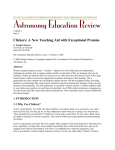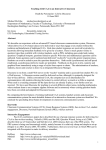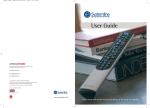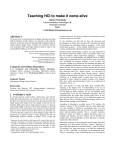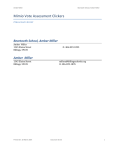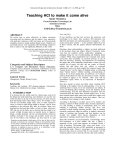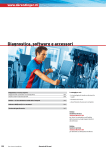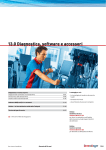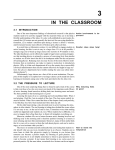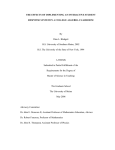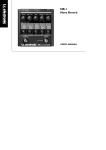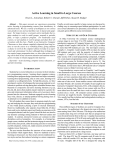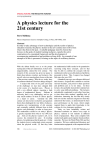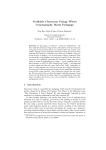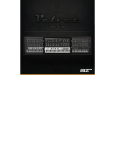Download maximising dialogue in lectures using group response systems
Transcript
Accepted for 7th IASTED Internat. Conf. on Computers and Advanced Technology in Education, Hawaii, 16-18th August 2004 Also available at www.dcs.gla.ac.uk/~quintin/papers/cate2004.pdf MAXIMISING DIALOGUE IN LECTURES USING GROUP RESPONSE SYSTEMS Quintin Cutts Dept. of Computing Science University of Glasgow Scotland [email protected] Gregor Kennedy Biomedical Multimedia Unit University of Melbourne Australia [email protected] Abstract Laurillard sees dialogue as a crucial component of learning and she states that it is almost impossible to achieve in lectures. This paper identifies eight impediments to dialogue in lectures, and shows how they are or can be overcome by (a) adjusting the activities that take place within lectures, (b) using existing Group Response Systems (GRSs), and (c) using extensions to GRSs proposed in this paper. In addition to facilitating dialogue within lectures, this paper shows how a record of the lecture-based dialogue could be used to improve learning environments outside the lecture. Key Words GRS, dialogue, lectures, handsets, learning, engagement Chris Mitchell Dept. of Computing Science University of Glasgow Scotland [email protected] Steve Draper Dept. of Psychology University of Glasgow Scotland [email protected] 2. Dialogue as a cornerstone to learning In Laurillard's conversational model of learning [1:p87], two key processes are at play. (Figure 1 presents a simplified version of the model.) First, there are communication flows from teacher (T) to learner (L), (1) and learner to teacher, (3). Second, there is active personal processing or reflection on information received, by either learner or teacher, represented by (2) and (4) respectively. 1 4 T L L 2 3 Figure 1: A simplified version of Laurillard's model 1. Introduction Laurillard identifies dialogue between teacher and learner as the heart of the educational process [1]. However, she dismisses large group teaching - such as lecturing - as an environment where effective learning cannot take place, because of the lack of opportunities for dialogue. However, the 10-year study of Mazur [2] and other work [3,4,23] show that the introduction of questioning into lectures, sometimes in conjunction with other interventions, radically increases the level of dialogue between students, and with their instructor. As Laurillard's model predicts, these interventions have been shown to improve educational performance significantly [5]. This paper analyses typical large group teaching situations and identifies eight impediments to the development of dialogue. It shows how the use of Group Response Systems (GRSs) [e.g. 6,7,8,9,10,11,12] addresses some of these impediments and plays a part in increasing levels of dialogue in large groups [e.g. 13,14]. Finally, it shows how an extended GRS developed at the University of Glasgow can be deployed to overcome the remaining impediments. In a typical learning situation, a teacher delivers knowledge, asks questions, and demonstrates skills to the learner (1). The learner then processes, engages with, and reflects upon the material they have received (2). The learner subsequently responds to the material and the teacher, given their current understanding (3). This may involve reframing the material or answering a question. Finally, the teacher uses the information in (3) to assess the current position of the student's understanding in relation to the intended learning outcomes (4), and if necessary reformulates and re-presents the material, thereby embarking on a new cycle of the process (1). 3. Impediments to dialogue in lectures Laurillard states that it is hard if not impossible to achieve dialogue in a traditional lecture or large-group teaching environment. She writes "The lecture is under consideration here only to provide a baseline for comparison… its inevitable one-to-many format maintains its position as very far from the ideal." [1:p93] There are a number of impediments to generating a dialogue in lectures, falling into the categories didactic mindset, oneto-many teaching, and learner-initiated dialogue. 3.1 Didactic mindset Lectures are still heavily relied on as a teaching method in higher education. Traditionally, they are predominantly didactic - although this will depend on numbers of students, lecturing style, etc. Given this didacticism, the following practical impediments arise when attempting to generate dialogue: • • • Time. Little or no time is allocated for dialogue, as a certain amount of material must be covered. Learner Attention. Learners are often struggling to transcribe what is being presented. Narrative. Teachers are unwilling to derail the carefully planned narrative of a lecture as a result of unexpected learner responses, because they 'must get through the material'. • • • • 3.2 One teacher: Many learners Laurillard's model assumes a single teacher in conversation with a single learner. In a constructivist philosophy of learning, the learner has a particular understanding of the concepts being studied at any point. The dialogue she recommends between teacher and learner allows that understanding to become apparent to both parties which is essential if the teacher is to assist in the learner's development. Large group teaching situations by definition comprise many learners. To extend Laurillard's model to these environments it appears that many dialogues are required, one for each learner, in which that learner's particular understanding is brought forward for the teacher to work with. This is clearly impossible to manage in a sizeable group, and any group teaching can be seen as a tradeoff between addressing the understandings of all individuals and the need to move forward the understanding of the group as a whole. Fortunately, most learners tend to have common misunderstandings of fundamentally difficult concepts and so the number of conversations required is reduced. For example, there may only be three fundamental understandings (or one correct understanding and two misunderstandings) of a particular concept, and so in this case only three dialogues are required. Additionally, in the one-to-one model, communication may be made using other mechanisms than speech. For example, the teacher may look over the learner's shoulder while they are working on an exercise, gaining feedback on the learner's understanding. On the basis of this feedback, the teacher may need to provide guidance to the learner. Here, feedback is coming continuously from the learner, but only occasionally does the teacher continue the dialogue. If dialogue is to support learning when there are many learners, a number of further practical issues must be addressed: Identified Responder. Learners tend to be reluctant to speak out amongst their peers, often for fear of looking stupid or getting the answer wrong. Response Range. It is difficult in a large group to discover the full range of understandings across all learners. Is it possible, for example, for all categories of learner response ('3' in Figure 1) to be received by the teacher? Response Relevance. It may not be appropriate for the teacher to address all prevailing misunderstandings. For example, too many other learners, on balance, may either be bored of or unable to understand a particular dialogue with a very small proportion of the whole group. Most lecturers will recognise this - a smart student attempting to start a discussion way over the heads of most other students. Monitoring Progress. How can the teacher effectively 'look over the shoulders' of all the learners in the group as they tackle an exercise? 3.3 Learner-initiated dialogue Laurillard's original model [1:p87] suggests an environment in which the teacher initiates dialogue at definite points in his/her exposition. However, the symmetry of Laurillard's model as depicted in Figure 1 suggests that the learner could be the one initiating the dialogue. For example, during an extended presentation by the teacher, the learner may interrupt and pose a question or make an observation which starts the dialogue cycle at step (3) rather than at step (1). Or, in the traditional seminar style, students may be asked to start the discussion. The teacher and/or other students now take on the role of responder. As already stated, multiple learners bring a range of interpretations of the material to the teaching situation. Given this, it is likely that questions are going to arise in learners' minds as mismatches occur between teacher's and learners' conceptions of the material being covered. Learners need to be able to air these questions and have them addressed to promote learning. This learnerinitiated dialogue is easy to handle in one-to-one teaching situations, but again, with many learners, there are practical issues to be resolved. • Learner-initiated dialogue. Learners may also share the Didactic Mindset with teachers, expecting that in-lecture material simply needs to be covered by the teacher and their role is one of transcription. With this mindset, content transmission becomes more important that understanding. The Identified Responder impediment is also a factor, possibly restricting a learner's ability to initiate dialogue within a session. As can be seen, there are theoretical reasons to promote dialogue in a large group teaching situation, but practical impediments make it difficult to create. The remainder of this paper shows how these impediments have been or could be overcome. 4. Overcoming impediments to dialogue in lectures using GRS Teachers have overcome some of the impediments outlined above using a number of strategies. Some large group teaching and learning methodologies, based around asking questions, are specifically designed to overcome the impediments of Time, Learner Attention and Narrative outlined in Section 3.1 [e.g. 3,14,15,25]. In these environments, significant time is allocated for dialogue; learners are given access to material before the teaching sessions and are expected to prepare for the sessions using it. Finally, teachers enter the classroom with only an outline for the session, fully expecting that the precise material covered will be identified through dialogue with the students. Another way to overcome the impediments is to use Group Response Systems (GRSs). A GRS enables a collective response to be gathered from the individuals in a group. Each group member typically has a handheld device which communicates with a central computer. Individual responses are collated by the computer and presented back to the group using a visual display (e.g. bar graph, pie chart, etc.). GRSs have been used to address the Identified Responder and Response Range impediments. These uses have taken place both in the redesigned environments mentioned above and also in more traditional settings. Reviewing the literature, GRSs have been employed to promote class-wide discussion between learners and the teacher, and also discussion between peers in lectures, in exam revision classes, in seminar groups, and in large group tutorials [13,14,15,16,17,18,25]. Numerous other benefits are also reported, including improved conceptual understanding, more student involvement and better debates, more accurate problem diagnosis, and immediate correction of misconceptions. Evaluation studies of the use of a GRS suggest that most students actively involve themselves in interactions, indicating that GRS use does help overcome the Identified Responder impediment. Draper & Brown reports on GRS use in a wide range of disciplines in one university [13] and quotes one students as saying "The anonymity [of responding using a GRS] allows students to answer without embarrassing themselves." In evaluations, over 85% of students attempted to work on and answer questions if a GRS was used, compared to only half that number if "hands-up" responses were sought. In situations where credit is given for responding, participation rates are reported to be even higher[15,19]. GRS questions are, in almost all cases, in a multiple choice format (except in IML's system [9] which allows free text responses), and so whether the Response Range impediment is effectively addressed depends on the quality of the multiple choice questions. In a good multiple choice question, each response option would relate to a common student understanding or misunderstanding of the material. The impediments of Response Relevance, Monitoring Progress and Learner-Initiated Dialogue identified in Section 3 have not yet been widely addressed using GRSs. However, it is the contention of this paper that the existing facilities of GRSs along with some additional facilities could be used to overcome these remaining impediments as well. 5. Extending GRS-created lecture dialogue Most existing GRSs are set up to allow the teacher to ask questions periodically throughout a session. The typical model of use is that the teacher stops lecturing, asks a question, waits while learners respond to the question using the GRS, and then continues the lecture making use of the aggregated responses displayed to the group by the GRS. However, the underlying technology of all GRSs consists essentially of a number of input devices, one for each group member, connected to a computer. The particular model of use described above is encoded into the software that interprets the messages being received by the computer from the input devices. Using the same base technology, but developing software that interprets the messages differently, alternative modes of interaction can be supported. Such a technique has been used at the University of Glasgow, using a GRS called PRS [6]. The PRS hardware is still used but the supplied software has been discarded in favour of software developed at Glasgow, known as QRS [20]. This software enables rapid prototyping of systems that interpret the handset responses of the PRS hardware in different ways. QRS has been used to promote the following forms of interaction. 5.1 The Clapometer The clapometer is a GRS response mode which continuously allows learners to respond to a question while the teacher is delivering material. Examples of the kinds of questions teachers may display are: • • Are you confused by the current topic? Are you bored by the current topic? Using the clapometer, students can respond at any time to these questions. Two of the buttons on the PRS handset are assigned to answering yes or no for each question. Initially it is assumed that the owner of the handset is answering no to all questions. Pressing one of the two yes buttons corresponds to a yes for the associated question, and the response will be immediately added to the current total of yes responses for the question. If at a later time a learner's opinion changes, he/she can press the corresponding no button to ensure this is recorded. The current response set can be continuously displayed either privately to the teacher or to the entire class. The clapometer can be used to address the LearnerInitiated Dialogue impediment. By using the clapometer, the learner, while not actually posing a question of their own, is flagging that they have something to say. The teacher is unlikely to hold up proceedings with just one response, but if a significant number of the class responds to a question, he/she could choose to act. The only way to expose the particular issue is to ask the class to articulate it. Usually, the Identified Responder impediment would prevent this, but given that many students have identified that they want to speak, learners are more likely to step forward. At the same time, Response Relevance issues are addressed, since the teacher uses the response display to assess the need for a change of direction. Note, however, that some learners' issues are likely not to be addressed when response rates are low. This issue will be addressed in Section 6. The most technically advanced GRS to the authors' knowledge [9], goes a step beyond the clapometer, by allowing text responses to be submitted. As considered in [21], questions submitted in this way could be displayed on a separate screen, and then other learners could respond showing that they wanted that question to be addressed as well. The Learner-Initiated Dialogue impediment is more directly addressed in this way. 5.2 Driving demonstrations/animations using a GRS The responses received by the GRS hardware could also be used to drive any piece of software. In the system developed at Glasgow, the most basic response handling software has been packaged up into a software library that can be incorporated into any program. The authors have used this with school pupils around Glasgow by connecting the GRS to a very simple space ship program in such a way that four handsets held by four users controlled one each of up, down, left and right. The four users could then work in tandem to fly the ship around the screen. In a proposed use of the QRS software in Pharmacology, an animation of the binding of drug molecules to binding sites can be adjusted using three sliders - one controls the concentration of the drug molecules, a second, the number of binding sites, and the third, how long a binding site typically holds onto a molecule. By connecting the QRS software to the animation, responses from the learners via the PRS handsets can directly control the sliders of the animation. The teacher may set an exercise for the class which is to work out how to set the sliders to maximize binding. The class in aggregate controls the animation to complete the exercise and both lecturer and students can observe what is happening to the sliders and to see the corresponding effect on the animation. The lecturer may observe the students setting the sliders inappropriately and provide additional content, information or hints, ask rhetorical questions, or comment on possible misunderstandings underlying the displayed behaviour. Both students who like to take part and those who like to observe are catered for. Such uses of a GRS help overcome the Monitoring Progress impediment. Whilst potentially expensive to set up, it has been shown that students who engage actively with demonstrations, rather than passively observing them, display significantly greater understanding of the underlying concepts [22]. Engagement with real-world activities, of which these demonstrations are a form, are a crucial part of Laurillard's original conversational model, represented in a simplified form in Figure 1 as part of activities (2) and (3). 6. Supporting dialogue outside lectures The impediment to dialogue in large lectures that remains to be addressed is that of Response Relevance, where the teacher will not always be able to adequately handle or address the full range of responses or questions presented by the class. This is particularly problematic when learners expend effort responding to or asking their own questions. If they find that they are given no response or feedback they may become disheartened and more prone to disengagement in the future. Given that dialogue between teacher and learner is essential to learning but cannot always take place in the formal group environment, a way of continuing the dialogue outside the group session is necessary. Can traditional teaching and learning mechanisms surrounding lectures support this? There are certainly some obstacles which are described below. In a traditional course, learning materials are typically prepared in advance to follow the sequence of the course. Consider for example, lecture presentations, tutor scripts, worksheets, laboratory exercises and so on. This material can only engage students effectively if the students' level of understanding is broadly similar to that expected by the materials' authors. In the case of lecture material, students will often leave lectures far from understanding what has been presented. When students subsequently attempt to tackle the material on their own, this mismatch can prevent their making any useful progress. This is further exacerbated by the lack of opportunity outside lectures for students to engage in any immediate dialogue. Small group teaching is one environment where this dialogue can potentially occur. Tutorials are designed to provide a relatively informal setting in which individuals are encouraged to come forward with misunderstandings arising in other areas of the course, such as lectures. In this setting, the course tutors are key players in continuing any dialogue initiated in lectures. Crucially, however, they were not party to this dialogue. They may at best get a summary of any discussion from the lecturer, or else they depend entirely on the students' re-voicing any misunderstandings. However, even though tutorials are designed to promote dialogue, as many tutors will know, learners are often unwilling to initiate dialogue in even these more intimate sessions, due to the Identified Responder impediment. In between lectures, the lecturer may choose to tune the content of the next lecture according to issues arising in earlier lectures. However, he/she may be unable to remember the range of responses made by learners during the lecture when typical response mechanisms are used, such as spoken or hands-up answers. Due to the poor response rates using these mechanisms, the remembered response may in any case be quite inaccurate. If so, then it will be hard to shape future materials so that misunderstandings are satisfactorily addressed. 6.1 GRS-collected data as glue The GRS-supported lecture has a tangible output available to the teaching team - the response sets - which can be used to address the problems outlined above. All GRSs collect and store the user responses in some form for later analysis. Typically, the data is only available to the teacher, and has been used for attendance checking and scoring. Crucially, however, the combination of the response data and the lecturer's materials, such as handouts or lecture slides, constitute a record of the lecture as delivered to a particular class. This is a valuable and immediate resource. The authors could find no evidence in the literature of the response data being used to scaffold further dialogue and yet, considering the following examples, it is well-suited for this task. In a lecture, lecturers may not have enough time in the session to fully process all the responses and work out how to respond to them (i.e., not enough time on step 4 in Figure 1). This is a particular problem when questions arise dynamically during class-time, and so the lecturer has not had time to consider how to address the particular response options, as he/she would have if the question was prepared prior to the session. Further processing by the lecturer without the time pressure of formal group teaching situation will enable sensible feedback to be given for all categories of learner response, using the web, e-mail or a handout. The response data may also be viewed by tutors to give them an idea of class progress. Since each individual response may be tagged to show which learner generated it, it is possible to show only the tutorial group's responses to a particular tutor. Precisely how this data is used is up to the tutor - from a general hint on progress, to knowing how individual students performed. Using Laurillard's model, the tutors are party to the lecture dialogue since they know how students responded to the lecturer's questions. They can scrutinise this before, and respond to it during, their next tutorial. If the response data is made available to all students, along with a forum for generating further discussion, students can revisit points in the lecture where their misunderstandings were not handled, spend further time processing - step (2) in Figure 1 - or ask questions using the forum - step (3). Both learners and the teaching team can be in the forum and can respond to questions essentially emulating Mazur's Peer Instruction [15] outside the lecture, and epitomising Peer Assisted Learning [24]. 6.2 Uses of GRS-collected data in Glasgow GRS response data has been used in two ways to support dialogue in the University of Glasgow. These were supported using facilities available in the QRS software, some of which are available in most GRSs. In the first application [20], handouts for the class consisted of the base material of the previous lecture augmented with the GRS questions and responses given by the learners and, crucially, a commentary by the lecturer on all the responses given by the class. This is a simple yet powerful solution consisting of no more than a text document with response graphs pasted in from the QRS software. Yet it contains significantly more information than the bare presentation. In the second application [20] considerably more technology is employed. On completion of a lecture, responses are downloaded to a central database. An application consisting of a set of web pages enables individual questions and their response sets to be viewed and augmented by lecturer, tutors and students in the class over the web. This system contains a number of features: • • • • • The questions are indexed by lecture and searchable. If a student answered a question in the lecture, they can view the group and their own response. They cannot see other students' individual responses. If a student did not answer during the lecture, they are not permitted to see the group response until they have attempted an answer themselves. The lecturer can set the system to flag the correct answer or not, as desired. Each question is the starting point for a web-based discussion forum. Any viewer can post to this forum, or respond to the postings of others. • • Selective viewing of the data is possible, for example to show only those responses generated by the members of a particular tutorial group. Students can re-vote if they wish. The data can be viewed to give the response set at any particular time (e.g. at the end of the lecture, a day after the lecture, now, and so on). This can give a sense of how the class viewpoint has changed over time with continued dialogue. 8. Conclusion Based on the theoretical position that dialogue is critical to learning, this paper has identified eight impediments to dialogue in lectures and has shown how these are already being, or could be, overcome with a combination of revised lecture-based activities or the use of a GRS. In addition to promoting in-lecture dialogue, GRSs also help students to further process their understandings outside the classroom. Moreover, data generated from in-lecture dialogue can also help lecturers and tutors refine their teaching materials to best meet the needs of their current students. A critical implication of the use of GRSs as described in this paper is that they support a notion of informed teaching. Traditionally 'informed teaching' has referred to the need for research to enhance teaching and learning in higher education. In this paper, the term is used to refer to lecturers, tutors and students themselves being informed about their shared learning process using open dialogue facilitated through the use of technology. 10. Acknowledgements We acknowledge Helen Purchase, from whom we first heard the term informed teaching. References: [1] D. Laurillard, Rethinking university teaching: a conversational framework for the effective use of learning technology, 2nd Ed. (London: RoutledgeFarmer, 2002). [2] C. Crouch & E. Mazur, Peer Instruction: Ten years of experience and results, Am. J. Physics, 69(9), 2001, 970-977. [3] G. Novak, E. Patterson, A. Gavrin and W. Christian, Just-in-time teaching: Blending Active Learning and Web Technology (Upper Saddle River, NJ: PrenticeHall, 1999). [4] D. Meltzer & K. Manivannan, Promoting interactivity in physics lecture classes, The Physics Teacher, 34, Feb 1996, 72-76. [5] R. Hake, Interactive-engagement vs. traditional methods: A six-thousand-student survey of mechanics test data for introductory physics courses, Am. J. Physics 66(1), 1998, 64-74. [6] PRS, http://www.educue.com [7] CPS, http://www.einstruction.com [8] TurningPoint, http://www.turningtechnologies.com [9] IML, http://www.iml.ltd.uk [10] RxShow, http://www.rxshow.com [11] Teamworker, www.uktraining.uk.com/teamwk.htm [12] Reply, http://www.replysystems.com [13 S. Draper, & M. Brown, Increasing interactivity in lectures using an electronic voting system, J. Comp. Assisted Learning in press. [14] J. Boyle & D. Nicol, Using classroom communication systems to support interaction and discussion in large class settings, Ass. Learning Tech. J. (ALT-J) 11(3), 2003, 43-57. [15] E. Mazur, Peer instruction: a user's manual (Upper Saddle River, NJ: Prentice-Hall, 1997). [16] A. Irving, M. Read, A. Hunt & S. Knight, Use of information technology in exam revision, Proc. 4th Int. C.A.A. Conf., Loughborough, UK, 2000. avail. online [17] C. Jones, M. Connolly, A. Gear & M. Read, Group interactive learning with group process support technology, Br. J. Educational Tech. 32(5), 2001, 571-581. [18] E. Wit, Who wants to be… The use of a personal response system in statistics teaching, MSOR Connections, 3(2), 2003, 5-11. [19] R. Burnstein & L. Lederman, Using wireless keypads in lecture classes, The Physics Teacher 39, 2001, 811. [20] QRS, http://www.dcs.gla.ac.uk/~quintin/QRS [21] S. Draper, J. Cargill & Q. Cutts, Electronically enhanced classroom interaction, Aus J. Educational Tech. 18(1), 1998, 13-23. [22] C. Crouch, A. Fagen, P. Callan & E. Mazur, Classroom demonstrations: learning tools or entertainment, Am. J. Physics in press. [23] S. Wolfman, Making lemonade: exploring the bright side of large lecture classes, Proc. SIGSCE '02, Covington, Kentucky, 2002, 257-261. [24] K. Topping, The effectiveness of peer tutoring in further and higher education: A typology and review of the literature. Higher Education 32(3), 1996, 321345. [25] R. Dufresne, W. Gerace, W. Leonard, J. Mestre, & L. Wenk, Classtalk: A Classroom Communication System for Active Learning, J. Comp in Higher Ed. 7, 1996, 3-47.






